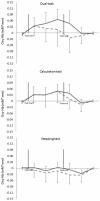Differences in dual-task performance and prefrontal cortex activation between younger and older adults
- PMID: 23327197
- PMCID: PMC3552708
- DOI: 10.1186/1471-2202-14-10
Differences in dual-task performance and prefrontal cortex activation between younger and older adults
Abstract
Background: The purpose of this study was to examine task-related changes in prefrontal cortex (PFC) activity during a dual-task in both healthy young and older adults and compare patterns of activation between the age groups. We also sought to determine whether brain activation during a dual-task relates to executive/attentional function and how measured factors associated with both of these functions vary between older and younger adults.
Results: Thirty-five healthy volunteers (20 young and 15 elderly) participated in this study. Near-infrared spectroscopy (NIRS) was employed to measure PFC activation during a single-task (performing calculations or stepping) and dual-task (performing both single-tasks at once). Cognitive function was assessed in the older patients with the Trail-making test part B (TMT-B). Major outcomes were task performance, brain activation during task (oxygenated haemoglobin: Oxy-Hb) measured by NIRS, and TMT-B score. Mixed ANOVAs were used to compare task factors and age groups in task performance. Mixed ANOVAs also compared task factors, age group and time factors in task-induced changes in measured Oxy-Hb. Among the older participants, correlations between the TMT-B score and Oxy-Hb values measured in each single-task and in the dual-task were examined using a Pearson correlation coefficient.Oxy-Hb values were significantly increased in both the calculation task and the dual-task within patients in both age groups. However, the Oxy-Hb values associated with there were higher in the older group during the post-task period for the dual-task. Also, there were significant negative correlations between both task-performance accuracy and Oxy-Hb values during the dual-task and participant TMT-B scores.
Conclusions: Older adults demonstrated age-specific PFC activation in response to dual-task challenge. There was also a significant negative correlation between PFC activation during dual-task and executive/attentional function. These findings suggest that the high cognitive load induced by dual-task activity generates increased PFC activity in older adults. However, this relationship appeared to be strongest in participants with better baseline attention and executive functions.
Figures




Similar articles
-
Depressive symptoms in older adults are associated with decreased cerebral oxygenation of the prefrontal cortex during a trail-making test.Arch Gerontol Geriatr. 2014 Sep-Oct;59(2):422-8. doi: 10.1016/j.archger.2014.07.003. Epub 2014 Jul 12. Arch Gerontol Geriatr. 2014. PMID: 25064032
-
Central artery stiffness is related to cerebral oxygenation hemodynamics during executive function tasks in healthy middle-aged and older adults.Exp Gerontol. 2018 Dec;114:93-98. doi: 10.1016/j.exger.2018.10.022. Epub 2018 Nov 3. Exp Gerontol. 2018. PMID: 30399407
-
Hemodynamic and behavioral changes in older adults during cognitively demanding dual tasks.Brain Behav. 2021 Mar;11(3):e02021. doi: 10.1002/brb3.2021. Epub 2021 Jan 8. Brain Behav. 2021. PMID: 33417301 Free PMC article.
-
The prefrontal cortex hemodynamic responses to dual-task paradigms in older adults: A systematic review and meta-analysis.Heliyon. 2023 Jul 6;9(7):e17812. doi: 10.1016/j.heliyon.2023.e17812. eCollection 2023 Jul. Heliyon. 2023. PMID: 37519646 Free PMC article. Review.
-
Prefrontal cortex and executive functions in healthy adults: a meta-analysis of structural neuroimaging studies.Neurosci Biobehav Rev. 2014 May;42:180-92. doi: 10.1016/j.neubiorev.2014.02.005. Epub 2014 Feb 23. Neurosci Biobehav Rev. 2014. PMID: 24568942 Free PMC article. Review.
Cited by
-
Prefrontal activation during dual-task seated stepping and walking performed by subacute stroke patients with hemiplegia.Front Neurosci. 2023 May 5;17:1169744. doi: 10.3389/fnins.2023.1169744. eCollection 2023. Front Neurosci. 2023. PMID: 37214400 Free PMC article.
-
Simultaneous fNIRS and thermal infrared imaging during cognitive task reveal autonomic correlates of prefrontal cortex activity.Sci Rep. 2015 Dec 3;5:17471. doi: 10.1038/srep17471. Sci Rep. 2015. PMID: 26632763 Free PMC article.
-
Cerebral Hemodynamics During a Cognitive-Motor Task Using the Limbs.Front Hum Neurosci. 2020 Nov 10;14:568030. doi: 10.3389/fnhum.2020.568030. eCollection 2020. Front Hum Neurosci. 2020. PMID: 33240062 Free PMC article.
-
Cognitive-Motor Interference Heightens the Prefrontal Cortical Activation and Deteriorates the Task Performance in Children With Hemiplegic Cerebral Palsy.Arch Phys Med Rehabil. 2021 Feb;102(2):225-232. doi: 10.1016/j.apmr.2020.08.014. Epub 2020 Sep 23. Arch Phys Med Rehabil. 2021. PMID: 32976843 Free PMC article.
-
Tai Chi practice enables prefrontal cortex bilateral activation and gait performance prioritization during dual-task negotiating obstacle in older adults.Front Aging Neurosci. 2022 Nov 18;14:1000427. doi: 10.3389/fnagi.2022.1000427. eCollection 2022. Front Aging Neurosci. 2022. PMID: 36466597 Free PMC article.
References
-
- Ardila A, Ostrosky-Solis F, Rosselli M, Gómez C. Age-related cognitive decline during normal aging: the complex effect of education. Arch Clin Neuropsychol. 2000;15:495–513. - PubMed
-
- O’Sullivan M, Jones D, Summers P, Morris R, Williams S, Markus H. Evidence for cortical “disconnection” as a mechanism of age-related cognitive decline. Neurology. 2000;57:632–638. - PubMed
-
- lzheimer's Disease International. World Alzheimer Report 2010 The Global Economic Impact of Dementia. London; 2010.
MeSH terms
Substances
LinkOut - more resources
Full Text Sources
Other Literature Sources
Medical
Miscellaneous

